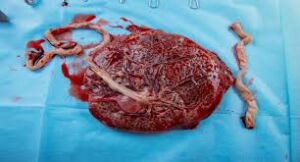Understanding the Third Stage of Labor: What Happens After Baby Arrives
The 3rd stage of labor is a crucial stage in the birthing process and is characterized by the birth of the placenta, or afterbirth. This stage commences with the delivery of the fetus and ends with delivery of the placenta and its attached membranes. During this stage, the mother’s uterus continues to contract, pushing out the placenta, which usually takes around 5-15 minutes. The mother also experiences a sensation of bearing down as with the baby during second stage; however, this can be quite different as it’s not just the pushing of a single body – rather it’s the pushing out of an organ that has been connected to her body for so many months. During this stage, doctors often check to make sure that all components of the placenta have been expelled. As soon as complete expulsion of the placenta has occurred and been confirmed by medical staff, uterine contractions will cease and bleeding will begin to slow down. It is from here that care providers can assess if any further treatments are necessary going forward. Please keep reading for details on the following topics:
Characteristics of the 3rd stage of labor
The placenta

CHARACTERISTICS OF THE 3rd STAGE OF LABOR
The 3rd stage of labor involves the delivery of the placenta, marking the completion of childbirth. Key characteristics include:
- Typically lasts around 5-15 minutes.
- Women may feel relief and shakiness post-delivery.
- Uterine contractions continue to expel the placenta.
- A small gush of blood indicates placental detachment.
- Healthcare providers gently pull on the umbilical cord while the woman bears down to aid placental delivery.
- Contractions persist to help the uterus return to its normal size and reduce bleeding.
- Medical Intervention: The abdomen will be massaged to help the uterus contract to decrease bleeding. Medication may be administered to prevent excessive bleeding.
- The placenta is inspected to ensure completeness, and any remaining fragments are removed.
- Any incisions or lacerations sustained during childbirth are stitched.
- Post-delivery, further monitoring and care are provided to the mother.
The placenta

The placenta is an organ that plays a vital role in mammalian reproductive processes. It is a temporary organ, formed within the uterus during pregnancy to provide nutrition and waste exchange between mother and fetus. This organ is composed of two layers: the chorionic plate, derived from the cells of the embryo and connecting them to the uterine wall; and the amnion, which is formed from an extra embryonic membrane containing amniotic fluid.
The placenta serves several essential functions during pregnancy:
-
Nutrient and Oxygen Exchange: The placenta acts as a bridge between the mother’s bloodstream and the developing fetus, facilitating the transfer of nutrients, oxygen, and other essential substances from the mother to the fetus.
- Waste Elimination: It also enables the removal of waste products, such as carbon dioxide and urea, from the fetus’s bloodstream, which are then eliminated through the mother’s circulation.
- Hormone Production: The placenta produces hormones crucial for maintaining pregnancy, such as human chorionic gonadotropin (hCG), which sustains the corpus luteum in the early stages, and progesterone and estrogen, which support the growth and development of the fetus.
- Immunological Protection: It provides a barrier against potentially harmful substances, including pathogens, to protect the fetus from infections that the mother’s immune system may encounter.
- Temperature Regulation: The placenta helps regulate the temperature of the fetus, ensuring a stable and optimal environment for development.
- Endocrine Function: Beyond hormone production, the placenta plays a role in endocrine signaling, influencing maternal physiological changes during pregnancy and labor.
-
Fetal Protection: It acts as a cushion, providing mechanical protection to the fetus against external trauma.
Key Processes in the Third Stage of Labor
- Placental Separation:
- The uterus continues to contract after the baby’s delivery, causing the placenta to detach from the uterine wall.
- Signs of placental separation include:
- A sudden gush of blood.
- Lengthening of the umbilical cord.
- The uterus becomes firm and rises in the abdomen.
- Expulsion of the Placenta:
- Once separated, the placenta is expelled through the vagina with the help of uterine contractions and gentle traction on the umbilical cord.
- Control of Bleeding:
- Uterine contractions compress the blood vessels where the placenta was attached, reducing blood loss.
- Medications like oxytocin may be administered to enhance uterine contractions and prevent excessive bleeding.
Methods of Managing the Third Stage
- Active Management:
- Involves interventions to expedite placental delivery and minimize blood loss. Key components include:
- Administration of uterotonic drugs (e.g., oxytocin) after the baby is delivered.
- Controlled cord traction to assist with placental expulsion.
- Immediate clamping and cutting of the umbilical cord.
- Involves interventions to expedite placental delivery and minimize blood loss. Key components include:
- Expectant (Physiological) Management:
- Involves allowing the placenta to deliver naturally without medical intervention.
- The mother relies on her own contractions and gravity to expel the placenta.
Care During the Third Stage
- Monitoring:
- Observe for signs of placental separation and excessive bleeding.
- Check the uterus for firmness and contraction.
- Fundal Massage:
- Gentle massage of the uterus may help it contract and prevent bleeding.
- Inspect the Placenta and Membranes:
- The placenta is examined to ensure it is complete, with no retained fragments.
- Administer Uterotonic Medications:
- Oxytocin or other drugs may be given to enhance uterine contraction.
👉 CLICK TO VIEW A VIDEO ON THE PLACENTA
Signs of a Retained Placenta
- Retained placenta occurs when the placenta is not delivered within 30 minutes of the baby’s birth. Possible causes include:
- Uterine atony: The uterus fails to contract effectively.
- Adherent placenta: The placenta is abnormally attached to the uterine wall (e.g., placenta accreta).
- Trapped placenta: The placenta detaches but cannot pass through the cervix.
Complications of the 3rd stage of labor
Complications refer to unexpected and adverse events that may occur, posing risks to the health and well-being of the mother and the baby. These complications can vary in severity and may require immediate medical intervention. Some common complications during the third stage of labor include:
- Retained Placenta: The placenta fails to detach from the uterine wall or is incompletely expelled, leading to prolonged bleeding, infection, or other complications.
- Postpartum Hemorrhage: Excessive bleeding following childbirth, often defined as blood loss exceeding 500 milliliters. This can result from factors such as uterine atony, retained placenta, or lacerations in the genital tract.
- Uterine Atony: The uterus fails to contract adequately after delivery, increasing the risk of postpartum hemorrhage.
- Uterine Inversion: The uterus turns inside out after childbirth, often due to excessive traction on the cord. It is a rare but potentially life-threatening complication requiring immediate medical attention.
- Perineal Tears or Lacerations: Tears in the tissue surrounding the vaginal opening can occur during childbirth, leading to pain, discomfort, and increased risk of infection.
- Infection: Infections of the uterus, perineum, or surrounding tissues can occur due to prolonged labor, invasive procedures, or other factors, leading to fever, pain, and other symptoms.
- Hematoma Formation: Blood clots may accumulate in the tissues surrounding the birth canal, causing swelling, pain, and potential complications if left untreated.
- Amniotic Fluid Embolism: A rare but serious condition where amniotic fluid or fetal material enters the maternal bloodstream, potentially leading to cardiovascular collapse and other complications.
- Maternal Exhaustion: Prolonged labor or complications during childbirth can result in maternal exhaustion, affecting the mother’s ability to care for herself and her newborn.
-
Neonatal Complications: Complications such as birth asphyxia, meconium aspiration, or neonatal sepsis can occur during childbirth, requiring immediate medical attention to ensure the baby’s well-being.
Disclaimer: The information provided in this content is for general informational purposes only. It is not intended as medical or healthcare advice, diagnosis, or treatment. Always seek the advice of a qualified healthcare professional with any questions you may have regarding a medical condition or healthcare decisions. 3rd stage 3rd stage

